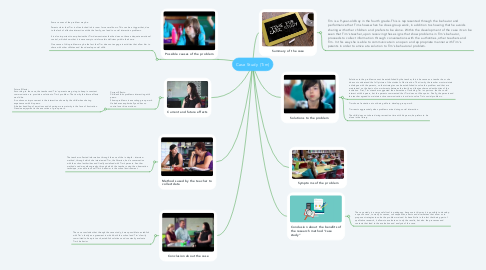Case Study (Tim)
by Gladys Andrade

1. Summary of the case
1.1. Tim is a 9-year-old boy in the fourth grade. This is represented through the behavior and performance that Tim shows when he does group work, in addition to showing that he avoids sharing with other children and prefers to be alone. Within the development of the case it can be seen that Tim's teacher, upon receiving these signs that show problems in Tim's behavior, proceeds to collect information through conversations with the authorities, other teachers and Tim. In this way she is able to communicate in an open and appropriate manner with Tim's parents in order to arrive at a solution to Tim's behavioral problem.
2. Symptoms of the problem
3. Possible causes of the problem
3.1. Some causes of the problem may be: Parents claim that Tim is often locked in his room for several hours. This can be a trigger that, due to the lack of affective interaction within the family, can lead to social interaction problems. It is also important to emphasize that Tim demonstrates that he does not have adequate emotional control, which shows that it is necessary to reinforce this deficiency within the home. One cause of this problem may be the fact that Tim does not engage in activities that allow him to share with other children and thus develop social skills.
4. Current and future effects
4.1. Current Effects: Child exhibits problems interacting with peers. Shows problems in executing group work. He behaves euphorically and has no control over his emotions.
4.1.1. Future Effects: According to the case, the teacher and Tim's parents are going to keep in constant communication to provide a solution to Tim's problem. That is why the future effects would be. A continuous improvement in the interaction shown by the child when sharing experiences with his peers. A better handling of emotions and showing more maturity in the face of frustration. Genuine enjoyment in the execution of group work.
5. Methods used by the teacher to collect data
5.1. The teacher collected information through the use of the in depth - interview method, through which she interviewed Tim, the librarian, had a conversation with the school authorities and finally socialized with Tim's parents. Another method used was ethnography, through which the teacher, using the observation technique, was able to show Tim's behavior in the school environment.
6. Solutions to the problem
6.1. Solutions to the problem cannot be established by the teacher, this is because as a teacher he or she does not understand the full picture of the student's life situation. That is why the teacher must maintain a dialogue with the parents, so that strategies can be established to solve the problem and that are maintained on the basis of commitments between the family and the teachers and authorities of the institution. First, Tim's teacher suggested the alternative of including Tim in sports so that he could interact with his peers, but the parents commented that Tim does not like sports. Finally, the parents and the teacher agreed to maintain active communication in order to solve Tim's social problems.
6.2. Tim shows frustration at not being able to develop group work. Tim reacts aggressively when problems arise during social interaction. The child does not share during recreation time with his peers; he prefers to be alone in the library.
7. Conclusion about the case
7.1. The case concludes that through the case study, it was possible to establish with Tim's family an agreement in which both the school and Tim's family committed to keep in touch, establish solutions and constantly evaluate Tim's behavior.
8. Conclusion about the benefits of the research method “case study”
8.1. The case study is a very useful tool in pedagogy, because in this way it is possible to develop a specific case, to study its causes, consequences, effects and alternatives that allow us to propose strategies to solve the problems raised. Its benefits lie in the fact that being part of qualitative research, it allows to evaluate not only the results, but also the processes and contexts that lead to the evaluation and analysis of the case.



